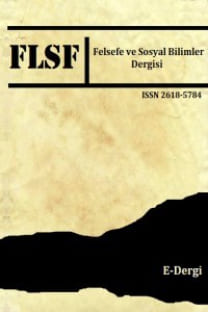W.F. HAUG’DA META ESTETİĞİNİN KRİTİĞİ
Bu incelemede Haug’un meta estetiğinin kritiği adlı eserinde tartışmaya açılan kavram ve uygulamaların eleştirel bir analizi yapılacaktır. Meta ve meta estetiğinin ulaşmış olduğu seviye, küresel teknoloji ve kapitalizmin değişime uğrattığı “ihtiyaç” kavramı ve “meta estetiği” uygulamalarının yaygınlık kazanmasında etkili olan kavramlar Haug tarafından titizlikle incelenir. Haug’a ek olarak bu incelemede kavramsal çerçeve daha da genişletilmek istenmiştir. Estetik soyutlama, manüple edilmiş toplumsal olarak üretilmiş ihtiyaç kavramı, meta fetişizmi, yabancılaşma, meta ve değişim değeri, lüks tüketimi, arzu-beğeni-tüketici post modernizmi, estetik yenileme, estetiğin aşınması, satış estetiği, Mcdonaldlaştırılmış estetik üretim ve kamusal alan gibi kavramlar birbirleriyle bağlantılı olarak ele alınmıştır. Böylece geniş bir kuram ve uygulama alanının iç içe geçmiş olduğu meta estetiğinde var olan kavramlar arası zorunlu ilişkiden hareketle meta estetiğinin işleyiş ve meşruiyet kazanma çabaları analiz edilmiştir. Meta estetiği, basit bir şekilde anlaşılacak “estetik-iktisadi ya da kültürel” bir fenomen olarak ele alınamaz. Çünkü meta estetiği hem “teknolojik ve kapitalist” uygulamalardan hem de yeni gelişen uygulamalı endüstriyel estetiğin disiplinlerarası eklektik uygulamalarından yararlanır. Kavramlararası zorunlu ilişkiye dayanarak sadece Haug’un konuyla ilgili düşüncelerini ele almak kendi içinde yeterli olmayacağı için tartışma genişletilmeye çalışılmıştır. Ayrıca bu incelemede ilk kez dile getirdiğimiz Mcdonaldlaştırılmış kitlesel estetik üretim, estetiğin metadan soyutlandığı ve meta estetiği üretim sisteminin temelde metanın kullanım değerini aşan bir görüntü üretim sistemi olduğu ve aynı zamanda gerçek üründen bağımsız işleyen bu duyusallaştırma teknokrasisinin aslında “metanın ötesinde ve metasızlaşan” bir praxis alan olduğu gerçekliğine ulaşılır. Ayrıca bu incelemenin sonuç kısmında Haug’un tartışmayı başlattığı ve yarım bıraktığı özel bir tartışma konusu ayrıca ele alınmıştır. Gelişmekte olan “Çin ve Türkiye” gibi ülkelerde “meta estetiğinin” gelişim sürecinin batı ile karşılaştırıldığında nasıl geçekleşeceğini düşünen Haug’un sorgulamasına cevap aranmış ve bu konuda ayrıntılı ve yeni bir incelemenin yapılması gerekliliği ortaya çıkmıştır
Critique of meta aesthetics in W.F. Haug
In this study, an analysis of concepts and applications discussed in the book called “critics of meta aesthetics” by Haug will be provided. Haug carefully examines meta and the level to which meta has reached, global technology, the concept of necessity that has changed significantly because of capitalism and the concepts which have contributed to the widespread use of meta aesthetics. In addition to Haug, conceptual frame has been aimed to be broadened more in this study. In meta aesthetics, in which many conceptual and application fields such as a concept of necessity that was manipulated and produced by the society, meta fetishism, alienation, meta and value of change, Mcdonaldized aesthetic production, desire, admiration, post modernism of the consumers, aesthetic renewal, erosion of aesthetics, advertisement, public place have been handled as correlated issues. So, the operation of meta aesthetics and its effort to gain legitimacy have been analyzed, based on the obligatory relationships between these concepts. Analysis of meta aesthetics is not an “aesthetic - economic or a cultural” phenomenon that can be understood easily. Because, “meta aesthetics” benefits from not only “aesthetic, technologic and capitalist” applications but also an eclectic and multidiscipline application field that has developed recently and differently. Based on the inevitable relationships between these concepts, we have tried to expand the discussion as it will not be enough to deal only with the ideas of Haug. As a result, it can be reached to the fact that in meta aesthetics there is an image production system in which there is only one type of aesthetics production that has been Mcdonaldized, mentioned for the first time in this study, aesthetics has been isolated from meta and the production system of meta basically exceeds the usage value of meta. Also it can be concluded that this sensitization technocracy that works independently from real product is actually a praxis area which is “beyond meta and without meta” Also, we have tried to find an answer to the question of Haug as to how development process of meta aesthetics will progress in developing countries such as “ China and Turkey” when compared with the west and it has become clear that a more detailed analysis needs to be carried out
___
- Abercrombie, S.(1990) A Philosophy of Interior Design, Icon Edition, Harper
- Adorno T.W.,(1997) Aesthetics Theory (Translated by R. H. Kentor) University of Minnesota Press, Minneapolis, USA
- Adorno,T.W, (1991) The Culture Industry, (ed.J.M.Bernstein) Routledge, London
- Bell,D.,(1978) The Culturel Cont radictions of Capitalism, Blackwell, New York, USA
- Benjamin W.,(1936) The Work of Art in the Age of Mechanical Reproduction
- Busse R., Design Darlegung zu einem weiten Begriff, Konstuktion, 46 Springer, Verlag
- Bürger P.,(2003) Avangarde Kuram (Çev. Erol Özbek) İletişim Yay. İstanbul
- Fraser Ian,(2008) Hegel ve Marx, İhtiyaç Kavramı (çev. B.Sumer Aydaş) Dost Ankara
- Ford H., (1922) My Life and Work, Garden City, New York, Doubleday
- Gropius W.,(1967) Yeni Mimarlık ve Bauhaus, (çev.Özgenül Aksoy, Erdem Aksoy) İstanbul, T.M.M.O.B. İstanbul Şubesi
- Haug W.F., (1986) Critique of Commodity Aesthetics, (Translated by R.Bock) University of Minnesota Minneapolis
- Haug W.F.,(2008) Meta Estetiğinin Eleştirisi, (çev.Metin Toprak)Felsefe Logos Yayınları, İstanbul
- Haug W.F.,(1999) Commodity Aesthetics as a Motor of Globalization
- Haug W.F.(1999) New Elements of a Theory of Commodity Aesthetics
- Haug W.F., (1999) Politisch Richtig oder Richtig Politisch. Linke Politik im Transnationalen High-Tec Kapitalismus, Hamburg
- Haug W.F. (1999) Commodity Aesthetics Revisited Exchange Relations as the Source of Antagonistic Aesthetization
- Haug W.F., (1999) Kaufhaus des Westens-A Retrospective
- Habermas J., (1999) Kamusallığın Yapısal Dönüşümü (çev.Tanıl Bora)
